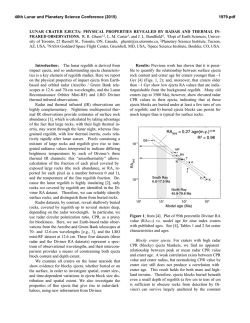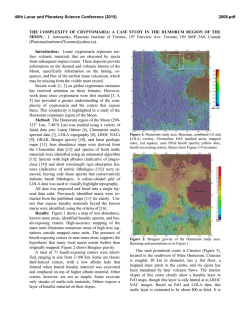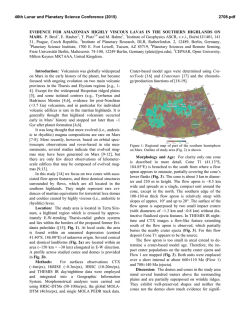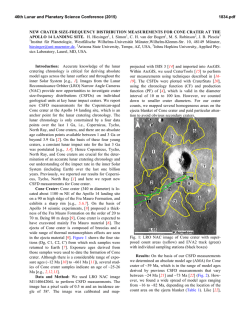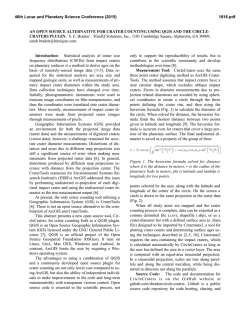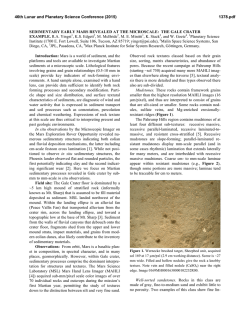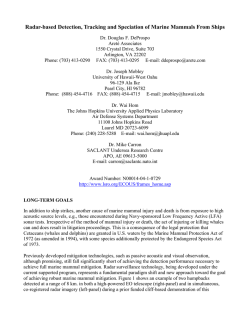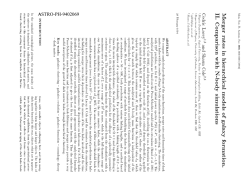
DATING RADAR DARK HALO CRATERS BASED ON POSTIMPACT
46th Lunar and Planetary Science Conference (2015) 1346.pdf DATING RADAR DARK HALO CRATERS BASED ON POSTIMPACT GARDENING PROCESS OF CRATER EJECTA. Jun Du and Wenzhe Fa, Institute of Remote Sensing and Geographical Information System, Peking University, Beijing 100871, China ([email protected], [email protected]). Introduction: In radar images of the Moon, a radar dark halo crater (RDHC) is usually identified by the presence of a low-return area surrounding the bright continuous ejecta blanket [1]. The radii of RDHCs range from 0.34 to 320 km and the radius of a dark halo is about 3-10 times the crater radius [1, 2]. In general, a radar dark halo has an echo strength 2-6 dB lower than its background and is thought to result from the distal fine-grained ejecta [1]. Once a RDHC formed, it began to be modified by meteoric bombardments, and as a result, its dark halo faded gradually. Since radar echoes depend mainly on near surface properties (e.g., rock size and abundance, ilmenite content) of the Moon, studies on radar dark haloes at different evolutionary stage can help to understand postimpact modification of the lunar surface and the evolution of crater ejecta. Previous study found that only craters of Early Imbrian age and younger have distinctive radar dark haloes [1]. Nevertheless, there is no study on the absolute age of each individual RDHC. To determine the absolute age of an individual crater, counting of small craters superposed on its ejecta and floor and radiometric measurement of its ejecta materials are two wellaccepted methods. However, the first method suffers from contamination of secondary craters, and the second method can be applied only to craters that were sampled. To avoid the above problems, Bell et al. developed a new method to date craters with diameter smaller than 3 km according to the evolution of their bright haloes in radar images [3]. This method is based on the assumption that if the lifetime of a bright halo is obtained, then the absolute age of the studied crater can be measured by the degradation state of the bright halo. In a similar way, we propose to determine the absolute age of a RDHC with any size based on the impact gardening process of the crater ejecta, which can provide a new dating method for lunar chronology studies. Methods: Since a RDHC is always young and fresh and its dark halo is on the distal area of crater ejecta, a three-layer model is used for the stratigraphy in the dark halo region: fine ejecta (thickness H), preimpact local regolith (thickness t), and underlying bedrock. After the formation of a RDHC, postimpact meteorites begin to penetrate through the fine-grained ejecta and preexisting regolith, fragmentize the bedrock, and then excavate blocky materials to the surface. The excavated fragments are emplaced on the top of fine-grained ejecta and mixed with local ejecta materials, resulting in an increase in radar return. With more and more meteorites impacting on the finegrained ejecta, radar echo strength increases gradually and finally the dark halo disappears. The lifetime of a dark halo (L) is therefore defined as the time length for these excavated fragments to elevate the radar echoes to their background level, which is the upper limit of the absolute age of a RDHC. If the degradation state of a bright halo, termed as “lifetime fraction” f [3], is figured out, the absolute age of a RDHC (T) can thus be expressed as: T=Lf (1) The procedure to determine the dark halo lifetime is as follows. (1) The bright and dark haloes radii (Rb and Rd) can be determined by vectorizing the haloes boundaries in radar images. (2) Using the ejecta thickness model h=0.14Rc0.74(r/Rc)-3.0 (r: the distance from a given point to crater center; Rc: the transient crater radius) [4], mean thickness of the fine-grained ejecta over the dark halo region can be obtained. (3) The excavation depth (Hexc) of an impactor that can excavate the bedrock and contaminate the dark halo therefore should be at least H+t, and this corresponds to a minimum diameter of Dmin = 10Hexc if the simple 1/10 relation between excavation depth and crater diameter is used [5]. (4) Using the previous identified 104 and 275 RDHCs at 12.6 and 70 cm wavelengths [2, 6], the relations between the bright halo radius and crater radius were obtained: Rsb =1.77Ra+1.79 and Rpb =2.10Ra+0.74 (Rsb and Rpb : the bright haloes radii at 12.6 and 70 cm; Ra: the apparent crater radius). This result indicates that a crater with a radius of Ra can produce a bright halo of Rb in radius on the top of radar dark halo. Besides, number of craters that can be generated in a 1 km2 region during a unit time can be obtained according to Neukum’s production function (NPF) [7]. Finally, if we integrate NPF from Dmin to Dmax (the maximum diameter of the crater superposed on the dark halo) and then multiply the resulting crater number by its corresponding bright halo area, the time length L for these newly generated bright haloes to completely contaminate 1 km2 radar dark halo area can be obtained. Similar to [3], to determine the lifetime fraction factor, all the RDHCs are firstly ranked by Rd/Ra (Rd: the radius of dark halo), then the cumulative frequency distribution (CFD) of RDHCs against Rd/Ra is constructed. By assuming that a RDHC with a larger Rd/Ra value is fresher, the lifetime fraction f is obtained as 46th Lunar and Planetary Science Conference (2015) the fraction of RDHCs that have dark halo radius larger than Rd in unit of Ra according to CFD. Results and Discussions: Taking Tycho as an example, its bright and dark haloes radii are vectorized as 189.1 km and 336.8 km in 70 cm radar image, respectively. Mean thickness of the fine-grained materials over its dark halo region is calculated to be 2.2 m. With an assumed regolith thickness of 15 m for lunar highlands [8], the excavation depth of the impactor should be 17.2 m at least. Therefore, the minimum diameter of a crater that can contaminate Tycho’s dark halo is 172 m. If NPF is integrated from 172 m to 10 km, the lifetime of Tycho’s dark halo is thus to be 0.76 Ga. Since 9% of RDHCs have larger Rd/Ra than Tycho, absolute age of Tycho is thus estimated to be 0.07 Ga. By assuming that regolith thicknesses over highlands, maria and highlands/maria boundaries are 15, 5 and 10 m, respectively, absolute ages of all the 12.6 and 70 cm RDHCs can be determined (Fig. 1). The results indicate that most of the RDHCs have ages smaller than 3 Ga, which agrees with previous study that most RDHCs are Eratosthenian and Copernican [1]. A positive correlation between absolute age and crater radius is observed, indicating that larger RDHCs are older than smaller ones. This is because that a larger RDHC usually has thicker fine-grained ejecta that require more time to be contaminated. For a given RDHC, dating results from radar images at different wavelengths should be consistent with each other. For Copernican-aged crater Lichtenberg [9], its absolute ages are estimated to be 0.16 and 0.13 Ga from 12.6 and 70 cm dark haloes. These two dating results are consistent with each other, and this is mainly because there is no significant difference in the bright and dark haloes radii at 12.6 (17.6 and 31.8 km) and 70 cm (17.8 and 35.9 km). Our results are also compared with the radiometric ages of four 70 cm RDHCs: Autolycus, Aristillus, Copernicus, and Tycho [10] (Table 1). We found that for larger RDHCs Copernicus and Tycho the estimation errors are less than 35%. However, for Autolycus and Aristillus the estimated ages are significantly smaller than their radiometric ages, which might arise from preimpact regolith thickness, halo radii, and production function of impact cratering. Conclusions: In this study we determined the absolute ages of RDHCs at 12.6 and 70 cm by modeling the impact gardening process of crater ejecta. The dating results indicate that most of the RDHCs are smaller than 3 Ga in age. The comparison between our results and radiometric ages implies that the method presented in this study is more appropriate for dating large RDHC. Dating impact crater by using radar images can thus be a crosscheck tool complementary to other da- 1346.pdf ting methods. In addition, our dating method can help to understand the postimpact evolution of crater ejecta: meteoric bombardments continuously impact on the distal fine-grained ejecta, excavate blocky materials to the lunar surface, and as a result, rock size and abundance are elevated to background level and radar dark halo disappears. On the other hand, the method presented here can also be used to constrain near surface properties of the Moon in a quantitative way, e.g., preimpact regolith thickness, ejecta thickness, and spatial variation of production function. References: [1] Ghent R. R. et al. (2005) JGR, doi: 10.1029/2004JE002366. [2] Du J. and Fa W. (2015) Icarus, to be submitted. [3] Bell S. W. et al. (2012) JGR, doi: 10.1029/2011JE004007. [4] McGetchin T. et al. (1973) EPSL, 20, 226–236. [5] Melosh H. J. (1989) Oxford Univ. Press, New York, 60–86. [6] Ghent R. R. et al. (2010) Icarus, 209, 818–835. [7] Neukum G. et al. (2001) Space Sci. Rev., 96, 55–86. [8] McKay D. et al. (1991) Cambridge Univ. Press, Cambridge, 285–386. [9] Wilhelms D. E. et al. (1987) USGS. [10] Grier J. A. et al. (2001) JGR, 106, 32847–32862 Figure 1. Estimated absolute ages of 12.6 (a) and 70 cm RDHCs (b) (gray dots). Black, red, and blue dots denote radiometric ages, dark halo lifetime, and the absolute ages of Autolycus, Aristillus, Copernicus and Tycho. Table 1. Dating results of four selected 70 cm RDHCs. RDHC C Crater radius (km) Lifetime (Ga) Autolycus Aristillus C Copernicus Tycho 21.4 28.0 49.7 44.5 0.14 0.27 1.27 0.76 Estimated age (Ga) 0.09 0.15 1.07 0.07 Radiometric age (Ga) 2.1 1.3 0.81 0.109
© Copyright 2025

